February 9, 2024 report
This article has been reviewed according to Science X's editorial process and policies. Editors have highlighted the following attributes while ensuring the content's credibility:
fact-checked
peer-reviewed publication
trusted source
proofread
SynMoss project grows moss with partially synthetic genes

A Chinese team of life scientists, microbiologists, plant researchers and seed designers has developed a way to grow engineered moss with partially synthetic genes. In their project, reported in the journal Nature Plants, the group engineered a moss that is one of the first living things to have multiple cells carrying a partially artificial chromosome.
Several research projects have been working toward the goal of creating plants with synthetic genes—such plants could be programmed to produce more food, for example, or more oxygen, or to pull more carbon dioxide from the air. Last year, one team of researchers developed a way to program up to half of the genome of yeast cells using synthetic genes.
In this new effort, the team in China upped the ante by replacing natural moss genes with genes created in a lab—moss is far more genetically complex than yeast. They call their project SynMoss.
The research team chose to work with moss primarily because a single cell can reproduce in ways that allow it to grow into an entire plant. It also has only 26 chromosomes. The team started with the genome's smallest portion, lopping off bits that prior research has shown the plant can live without. They also removed what they deemed unnecessary transposons.
Next, they added labels to allow for easy identification of synthetic parts after the plant was mature. They also made changes to the plant's genetic code to stop production of a certain protein and carried out what they describe as other tweaks. In all, they reduced the part of the chromosome they were editing by just over half.
Then, as the final step, they added the synthetic structure they had built previously. The team then nurtured the moss cell, watching as it split and eventually grew into a full-sized moss plant.
The researchers found that the plant appeared normal—its size and shape were average and its reproductive processes performed as normal. They also found that it was just as resistant to salt and other environment stresses as others that had not been altered, though they did find that some of its genes were more active than normal, which, they note, could prove to be troublesome.
More information: Lian-Ge Chen et al, A designer synthetic chromosome fragment functions in moss, Nature Plants (2024). DOI: 10.1038/s41477-023-01595-7
Journal information: Nature Plants
© 2024 Science X Network




















